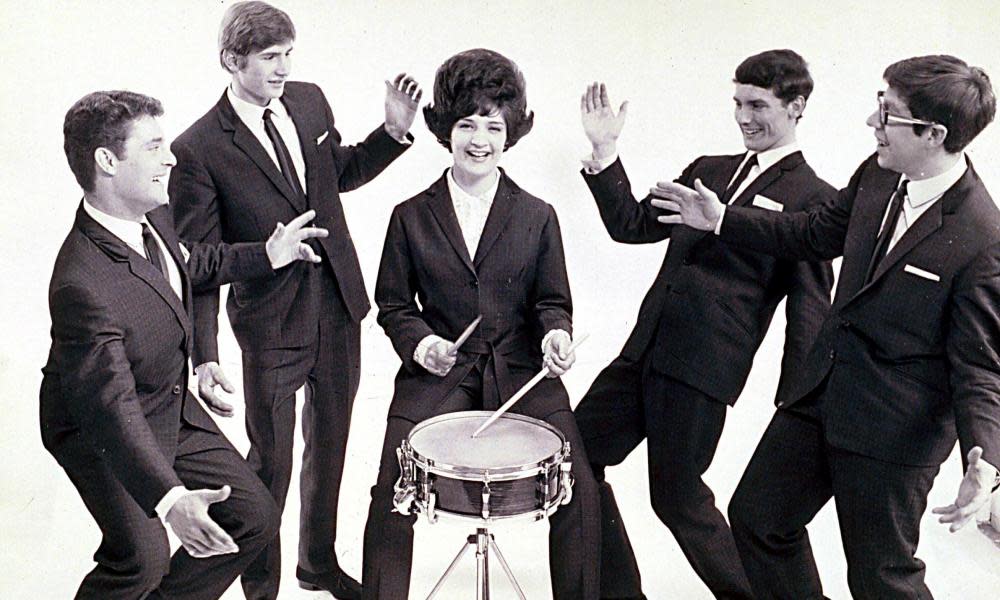Honey Lantree obituary

Honey Lantree, who has died aged 75, was that rare thing in a 1960s beat group – a woman. As the drummer of the Honeycombs, who had a No 1 UK hit with Have I the Right in 1964, she disliked being dismissed as “a gimmick”, nor did she buy into the idea of being a pioneer. She just happened to be good on the drums, and that’s the way it was.
The height of Honey’s fame came in the mid-60s when, immediately after the success of Have I the Right, she became the focal point of interest in the band and a magnet for magazines, which chose mainly to write about her clothes, her hair and her looks. In the wake of their hit single, the Honeycombs undertook a two-month tour of one-nighters with Gene Vincent, Lulu and the Applejacks (who had a female bass player), and then visited Scandinavia, Australia and the south-east Asia, where they had a Japanese hit with Love in Tokyo.
Further UK hits were forthcoming with Is It Because (No 38), Something Better Beginning (No 39, written by Ray Davies) and That’s the Way (No 12). The band also released two well-received studio albums, All Systems Go! (1964) and It’s the Honeycombs (1965), while Honey also showed her singing prowess on Something I Got to Tell You, which deserved to be a single but was never released as such. On each of the band’s recordings the drumming was all her own work and she stressed that, unlike many band members in other 60s groups, she had never been replaced by a session musician.
When the Honeycombs split in 1967, Honey disappeared from the music scene to raise a family, but in later life returned to playing live with a reincarnated version of the group from the 80s onwards.
She was born Anne Lantree in Hayes, Middlesex, to Nora (nee Gould) a civil servant, and her husband, John Lantree, a signwriter. After attending Sydney Burnell school in Highams Park in Essex, Anne began to focus on a career as a hairdresser, training in a salon in Hackney, east London. However, the owner of the salon, Martin Murray, also led an amateur group called the Sheratons. Its members would sometimes leave their instruments at his house and one day, in 1963, Anne picked up the drumsticks and found that she had a natural talent. “My jaw dropped,” said Murray, “she was in perfect time and was soon playing like a pro.”
Murray also showed Anne’s brother, John, how to play the bass, and so the line-up of the Sheratons evolved into one featuring Murray, the two Lantrees, Alan Ward on lead guitar and Denis D’Ell on vocals. They were given a residency at the Mildmay Tavern in Islington, north London, and became so popular that the landlord offered them work five nights a week, shutting the doors at 9pm because the place was already full.
From there they secured an audition with the maverick producer Joe Meek, who had his own studio in the nearby Holloway Road. When Meek saw the band had a female drummer, he quickly recognised a valuable selling point.
At that stage the group were performing covers such as Baby It’s You, 24 Hours from Tulsa and some rhythm and blues favourites. But new material soon came from Ken Howard and Alan Blaikley, floor managers at the BBC who had begun to write songs in their spare time. They heard the Sheratons and offered them some new material, including Have I the Right.
Meek immediately cottoned on to the song’s potential: the Dave Clark Five had just had a No 1 UK hit with Bits and Pieces, and he thought a similar stamping beat could be employed for the chorus of Have I the Right. Anne thumped the drums heavily and Meek overdubbed some boot stomping from the rest of the group on the studio’s wooden stairs.
The single was licensed to Pye Records but their managing director Louis Benjamin wanted a name change for the band, suggesting to the members: “You can be the Honeycombs and Anne can be Honey.” Under their new moniker Have I The Right was proclaimed record of the week on the pirate station Radio Caroline and within three weeks they were at No 1, replacing Manfred Mann’s Do Wah Diddy Diddy on Anne’s 21st birthday. The single sold more than a million copies in the UK and also became an international hit, making the top 10 in the US and No 1 in Australia, South Africa and Japan.
The following year Anne and D’Ell sang together on another Howard-Blaikley number, That’s the Way, and it spent 14 weeks in the UK charts. But the heights had already been scaled and over the next two years the band’s impact waned. In 1967 Meek, plagued with mental health problems, took his own life. Then Howard and Blaikley switched to work mainly for Dave Dee, Dozy, Beaky, Mick and Tich, and a slightly rearranged Honeycombs line-up decided to move into cabaret. Their fortunes did not improve and they disbanded later that year.
Anne went on to marry David Coxall, a pensions administrator, in 1969, and spent most of the next two decades raising their two sons, Matthew and Simon. A reconstituted version of the Honeycombs returned in the 1980s with Anne playing drums and continued as a live act until D’Ell’s death in 2005.
David died earlier this year. Anne is survived by their children and five grandchildren.
• Honey Lantree (Anne Margot Lantree), drummer; born 28 August 1943; died 23 December 2018

 Yahoo News
Yahoo News 
